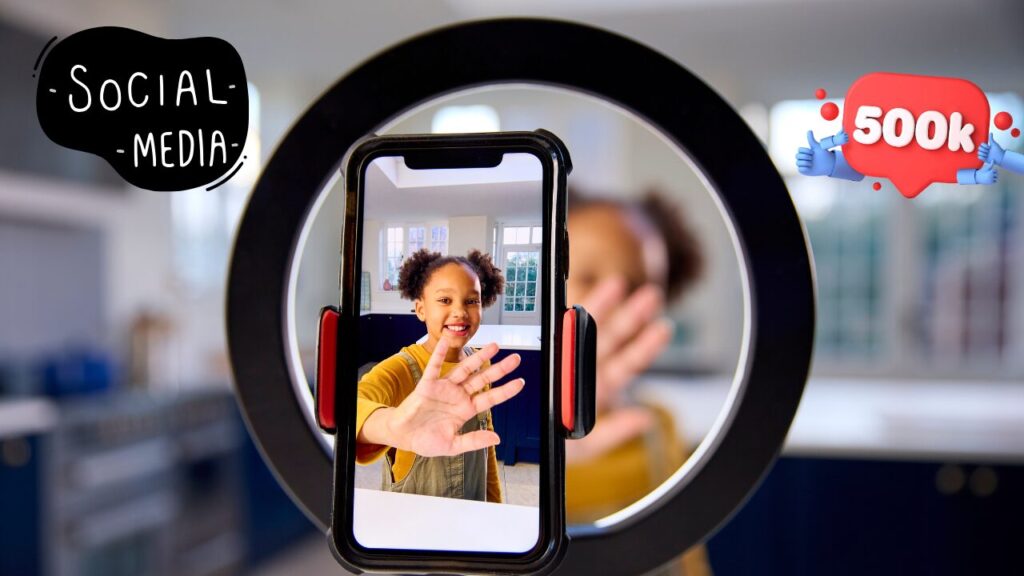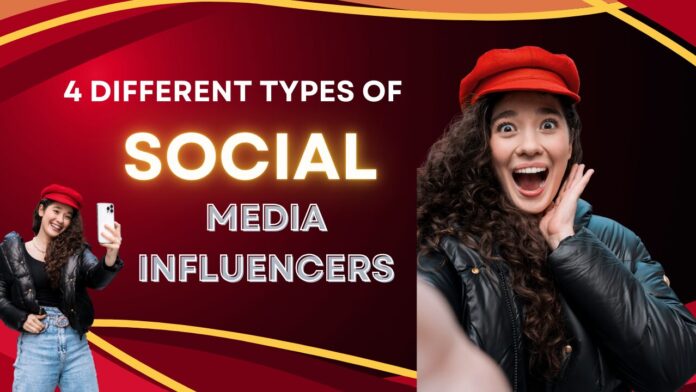Table of Contents
Introduction: 4 Different Types of Social Media Influencers
Explore the 4 different types of social media influencers! Learn about their unique characteristics, target audiences, and how they shape online trends. Social media has revolutionized how brands communicate with their target audience, and social media influencers have become a new type of communication channel for businesses. Leveraging influencer marketing has proven effective in driving engagement, increasing brand awareness, and enhancing credibility. But not all influencers are created equal. To maximize your marketing efforts, understanding the four different types of social media influencers Mega, Macro, Micro, and Nano is crucial.
This post is about each of these influencer categories in depth, and how they can help your brand strategy.
What Are Social Media Influencers?
A social media influencer is someone who has cultivated a significant and dedicated audience across various social media channels. They hold the power to influence their audience’s purchasing decisions due to their credibility, knowledge, and relatability in specific niches.
Brands collaborate with influencers to reach highly engaged audiences that traditional advertising may fail to connect with. This mutually beneficial partnership helps both sides: the influencer receives increased visibility and financial incentives, while the brand enjoys enhanced recognition and credibility.
Why Are Influencers a New Form of Brand Communication?
In the current digital landscape, old marketing strategies such as TV ads or paper media are becoming less effective. Social media influencers connect brands with their audiences by sharing real and tailored messages. They can talk directly to consumers, which creates trust and builds real connections, something traditional marketing finds hard to do.
By using different kinds of influencers, brands can match their marketing strategies to their budget, audience size, and goals. Let’s look at these types more closely.
1. Mega Influencers
Mega influencers sit at the top of social media popularity. These individuals have more than 1 million followers on sites like Instagram, TikTok, or YouTube. They are often celebrities, athletes, or well-known figures who have moved beyond specific markets to achieve broad recognition.
Features of Mega Influencers
- Huge Reach: With millions of followers, Mega influencers possess unmatched reach, able to present your brand to an international audience.
- High Costs: Collaborating with them often involves significant financial investment.
- Broad Appeal: They have diverse followers, which means less focus on specific niches.
When to Use Mega Influencers
Brands aiming for maximum visibility during major product launches or campaigns often work with Mega influencers are important. For example, a high-end fashion brand launching a new line could work with a Mega influencer to create buzz and get attention.
Example:
Selena Gomez is a celebrity influencer with millions of Instagram followers, which makes her a top Mega influencer. Brands such as Coach and Puma have used her wide reach effectively.
Mega Influencers Who Are Not Celebrities
There are also non-celebrity individuals who have become mega influencers thanks to social media, often amassing millions of followers.
Key Examples:
- Marques Brownlee (MKBHD): Tech expert and reviewer with a massive YouTube presence.
- Pamela Reif: Fitness coach and influencer with a dedicated global audience.
Unique Appeal: Known for expertise and authenticity rather than traditional fame.
Impact: Rival traditional celebrities in reach and engagement, making them valuable in influencer marketing.

Macro Influencers
Macro influencers have 100K – 1M followers. Though they might not be as well-known as Mega influencers, they tend to be niche experts which is a powerful weapon for targeted campaigns.
Characteristics of Macro Influencers
- Targeted Reach: They usually have a loyal audience within specific areas, such as fitness, fashion, or tech.
- Higher Engagement: Their followers are often more engaged than those of Mega influencers.
- More Accessible: They are easier to collaborate with compared to Mega influencers in terms of cost and availability.
When to Use Macro Influencers
Macro influencers are a great option for brands seeking to get the best of both worlds. They’re aimed at a targeted group, and so are good for niche market campaigns.
Example
Fitness & Health & Wellness Influencer Pamela Reif has a large following who love her posts. Companies who target fitness-lovers can benefit from collaborating with influencers such as her.
3. Micro Influencers
There are micro influencers with 10,000-100,000. They have small followings but are active in small groups and love to connect with the fans.
Characteristics of Micro Influencers
- High Trust Levels: Their followers view them as authentic and approachable.
- Affordable Partnerships: Working with Micro influencers is cost-effective, making them perfect for brands with smaller marketing budgets.
- Exceptional Engagement Rates: Their content frequently sparks meaningful interactions.
When to Use Micro Influencers
If your goal is to build trust and foster deeper engagement in niche markets, Micro influencers are an excellent choice. They excel in creating genuine content that resonates with specific audiences.
Example
A local coffee shop aiming to target coffee enthusiasts might work with a Micro influencer who specializes in reviewing cafes and coffee products.
4. Nano Influencers
Nano influencers are the newest and smallest category, with followers ranging from 1,000 to 10,000. They are everyday individuals with a modest but highly engaged audience.
Characteristics of Nano Influencers
- Strong Community Bonds: Nano influencers maintain personal relationships with many of their followers, resulting in unparalleled trust and influence.
- Low Cost: Partnering with them is very budget-friendly.
- Hyperlocal Focus: They are ideal for targeting specific geographical regions or ultra-niche audiences.
When to Use Nano Influencers
For hyperlocal campaigns or promoting smaller brands and businesses, Nano influencers can provide exceptional value. Their audience often views their content as relatable and trustworthy.
Example
A small bakery could collaborate with a local Nano influencer that knows their area to get them noticed.
Celebrity Influencers
Influencers of celebrity, whether old stars such as actors and athletes, or the latest hot shot like Kylie Jenner and Charli D’Amelio have a million followers and massive influence. They can get brands’ message heard nowhere else, but it can be expensive and risky to partner if there are problems or it isn’t aligned with the brand. Careful selection is key to leveraging their reach effectively.
Selecting the Perfect Social Media Influencer for Your Brand

Selecting the right social media influencer depends on your marketing objectives, budget, and target audience. Here’s a brief guide to assist you in making your decision.
- Mega Influencers: Opt for them when seeking massive brand awareness.
- Macro Influencers: Choose them for balancing reach and niche engagement.
- Micro Influencers: Use them for deep connections in specific niches.
- Nano Influencers: Engage them for cost-effective, local campaigns.
Industry Experts and Thought Leaders
- Who Are They? The following are the descriptions of industry experts and thought leaders that are defined as individuals who are reputed and credited for their expertise, knowledge, and authority within certain discipline areas by the general public and academia.
They are usually regarded as authoritative personalities and experts in their relevant fields and are expected to provide the audience with credible information regarding the matters in question.
- Their Influence in Specific Niches: They thus determine trends, direct decisions, and build trust in the minds of professionals and consumers. Their opinions and strategies often set benchmarks for best practices in their domains.
- Platforms forums of Best or Successful and Suited Collaborations: webinars expert, Stakeholder for are guest exposure collaborations
- Thought most blogs, and for Leaders: effective co-authored authority example, LinkedIn, for whitepapers, of brands Twitter, sharing or both with Medium, entities. information, panel experts YouTube, interacting discussions can and with at include; industry others industry webinars specific and events with creating which authority.
- Advantages for B2B Marketing: By engaging with thought leaders, it helps enhance the brand’s image, target harder to reach audiences, increase the number of leads, and increase the brand’s authority as it associates with a credible voice within the B2B industry.
Content Creators and Artists
Content creators and artists are the creative influencers who are known for generating unique and interesting content in different industries including art, music, photography, and writing. They are active on social media sites such as Instagram, TikTok, YouTube and Patreon and display their work to followers.
Through creating real relations and providing valuable content, they create tribes. Special considerations include a wide range of categories, including digital artists and viral musicians, as well as photographers telling meaningful visual narratives.

How to Make the Right Choice
To identify the right type of influencer with whom to work, there are several crucial factors that need to be considered very carefully:
- Objectives of the Campaign: Should your ambition be to amplify widespread brand visibility, partnering with mega or macro influencers may yield the desired outcome. Conversely, if your intent is to foster trust, boost conversions, or target a highly specific niche, micro or nano influencers often prove more efficacious.
- Financial Considerations: Mega influencers typically demand significant investment. For constrained budgets, leveraging multiple micro or nano influencers can offer superior returns on investment while ensuring a more precisely calibrated approach.
- Audience Congruence: Ensure the influencer’s audience mirrors your target demographic. A smaller yet highly engaged following that aligns with your brand’s ethos can surpass the value of a larger audience with minimal relevance to your objectives.
- Engagement Metrics: An extensive follower count does not guarantee fruitful outcomes. Scrutinize engagement metrics to determine the extent of the audience’s interaction and genuine interest in the influencer’s content.
- Caliber of Content: Examine the quality of the influencer’s output. Are their visuals, videos, or written pieces aligned with your brand’s visual identity and messaging? The stylistic coherence of their material with the story of your business is important.
- Genuineness: Influencer marketing is all about authenticity. Audiences are getting more savvy about inauthentic endorsements. Work with people with whom your product or service is closely aligned — then with influencers who genuinely believe in your product and can promote it with credibility and integrity.
The Future of Social Media Influencers
As the online world continues to change, the influence of digital creators is also transforming. Today’s consumers value authenticity and personal connections, and different Types of social media influencers fill this need effectively. Brands that harness the power of influencers across different categories will stay ahead of the curve, reaching their audiences with targeted and impactful messaging.
Conclusion: 4 Different Types of Social Media Influencers
Social media influencers are more than just internet personalities; they are a transformative force in the marketing world. Whether it’s different Types of Social Media Influencers: Mega, Macro, Micro, and Nano, each category offers unique opportunities for brands to connect with their audience.
By understanding the characteristics and benefits of these influencers, you can craft a strategy that drives engagement, builds trust, and ultimately boosts your brand’s success. Start integrating influencer marketing into your strategy today and witness how this new type of communication for brands can take your business to new heights!



Thanks for sharing. I read many of your blog posts, cool, your blog is very good.
Thanks
Thanks for sharing. I read many of your blog posts, cool, your blog is very good.
Thanks